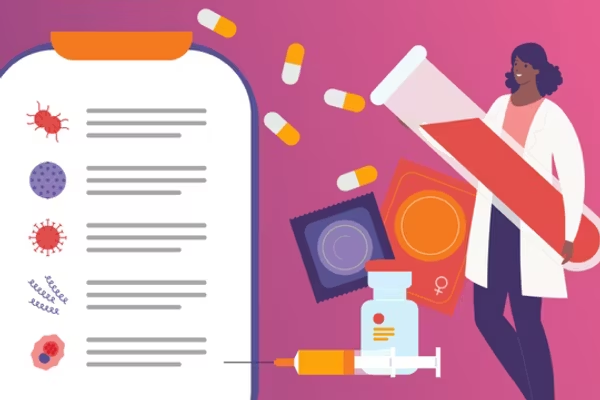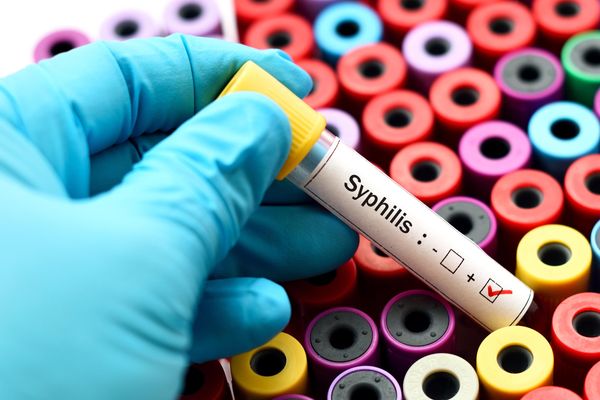Although you no longer need to worry about pregnancy once you're officially in menopause (yay!), you still need to protect yourself against sexually transmitted infections (STIs) — which are increasing among midlife women.
What, what?
That's right. When it comes to STIs, age does not discriminate. Among all ages, the rate of STIs is rising in the U.S., and that rise is especially evident among older adults. In fact, the biggest increase of in-office treatments for STIs was reported to be in patients over age 60.
Read: You're Never Too Old to Get an STI >>
First, I need a refresher. It's been a while since I've thought about STIs.
STIs (sexually transmitted infections) include syphilis, gonorrhea, chlamydial infections, genital herpes, hepatitis B, genital warts, HIV/AIDS, human papillomavirus (HPV) and trichomoniasis.
And you get STIs through intercourse, right?
You can get them by oral, anal or vaginal sex, and they can also be transmitted by genital touching.
For a lot of people, there's a stigma around STIs. How do I deal with that?
It might help to know that STIs are incredibly common. The Centers for Disease Control and Prevention reports about 20 million new cases each year. It's also important to know that not every infection leads to disease, which is why many healthcare professionals prefer the term "STIs," with the "I" meaning infection, instead of STDs, with the "D" meaning disease.
So, what's going on to account for the rising rate among older men and women?
- As we age, our immune system is weaker, making it tougher to fight off infection and disease.
- With menopause, many women feel a renewed sense of sexual freedom. They might be widowed or divorced and out on the dating scene, no longer monogamous.
- Due to the availability of medications (like Viagra) and greater awareness of things like vaginal lubricants and moisturizers, having sex is easier for older adults.
- There's really no way to know if your partner has an STI (and he or she might not even know it), because many times the symptoms are not apparent right away. Yet, you can catch it before that person is even symptomatic.
- Falling estrogen levels can lead to thinning of the vaginal tissues, making them more vulnerable to tearing. These micro abrasions can then make it easier for infections and pathogens to enter.
How do you know you have an STI?
Sometimes there are no symptoms — at least not for a while. But the good news is that if you can catch an STI early, some are easier to treat at that stage, usually with a course of antibiotics or antivirals.
Some symptoms include:
- Fever, headache or sore throat
- Rash
- Fatigue
- Vaginal discharge, rash or itching
- Sores, bumps or warts near the mouth, vagina or anus
- Painful or burning urination
- Pain during intercourse
Read: 6 STIs You Need to Know About >>
Sounds scary — so, how can we protect ourselves?
- Use a condom. Although condoms don't totally remove the risk, they can significantly lower your chances of contracting an STI. Did you know that a female (or "internal") condom can also help protect against STIs? Here's some information on that.
- Get tested, along with your partner, for STIs. And get treated, if necessary.
- Limit the number of sexual partners you have. That increases the odds of contracting an STI.
- Get screened. A simple blood test can detect HIV and syphilis. For chlamydia and gonorrhea it's a throat swab, a swab of the vagina or penis or a urine sample. Annual screening is recommended if you have multiple partners.
- Vaccines are available for two STIs: hepatitis B and HPV.
What happens if you don't treat an STI?
Untreated, your risk for another STI increases, because having one stimulates an immune response in your genital area that can then raise the risk of HIV. Also, untreated STIs can lead to certain types of cancer, infertility or organ damage. Learn more about cervical cancer.
Any encouraging news to share?
Yes! Many STIs are highly preventable, treatable and curable. Currently curable are syphilis, gonorrhea, chlamydia and trichomoniasis. Incurable are hepatitis B, herpes simplex virus (HSV or herpes), HIV and HPV. But those that are incurable can be reduced or modified through treatment, according to the World Health Organization.







